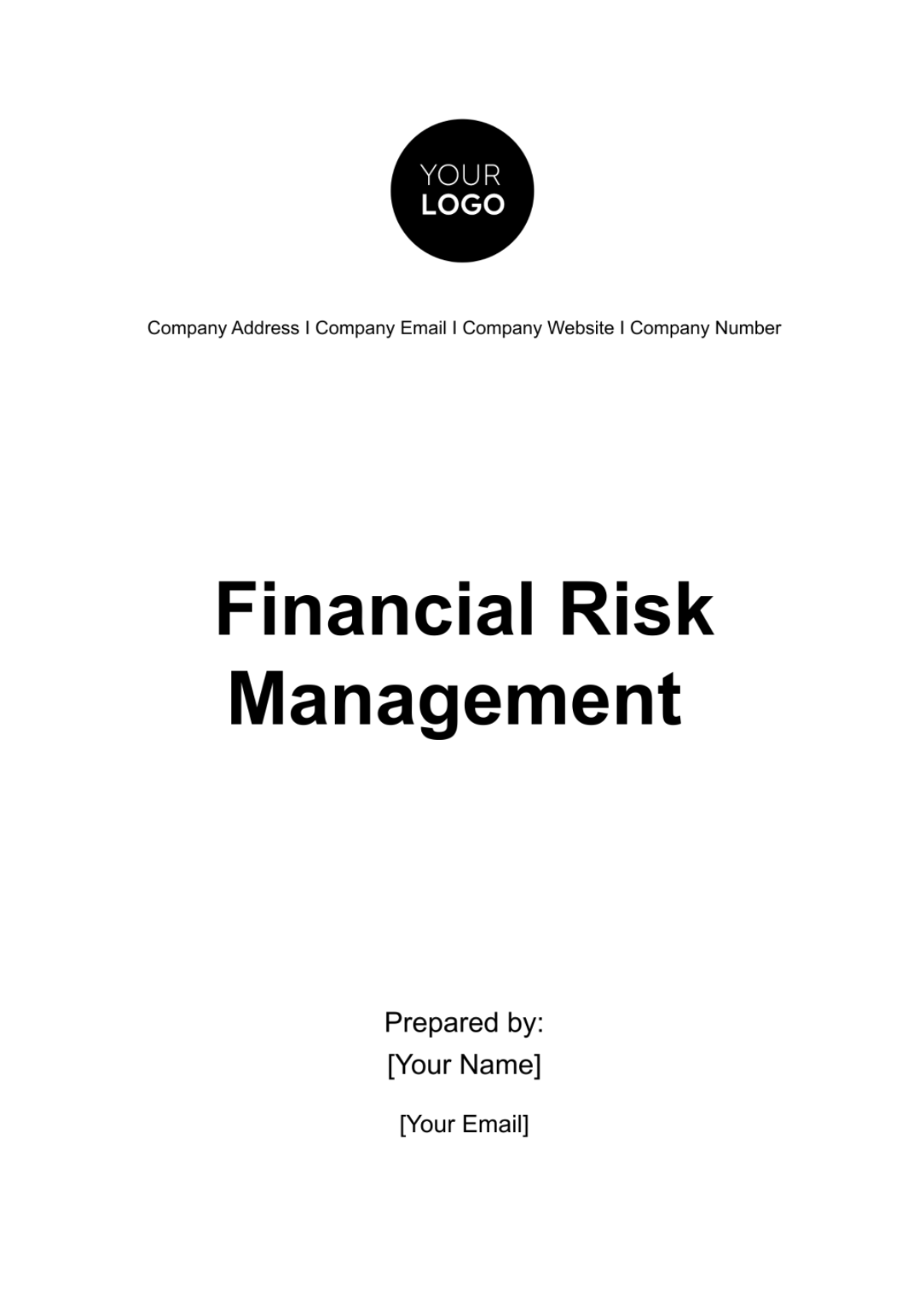Free Financial Risk Management

I. Introduction to Financial Risk Management
Definition and Importance of Financial Risk Management
At [Your Company Name], financial risk management is the process of understanding, analyzing, and addressing the potential financial losses that our operations might encounter. This discipline is crucial for the stability and profitability of our operations, as it helps us mitigate financial risks associated with market fluctuations, credit operations, liquidity constraints, and operational failures. Effective financial risk management ensures we maintain a robust position against uncertainties, thus safeguarding our assets, enhancing profitability, and securing shareholder value.
Types of Financial Risks
Market Risk:
This involves the risk of losses in our portfolios due to the movement in market prices. For instance, changes in interest rates, stock prices, currencies, and commodity prices can adversely affect our investment value.
Credit Risk:
It represents the risk of loss from a borrower who fails to fulfill their obligations. In our credit operations, we assess and manage the likelihood of our clients defaulting on their payments.
Liquidity Risk:
This is the risk of being unable to meet our short-term financial demands. It reflects our ability to convert assets into cash quickly or obtain adequate funding to handle our operations without incurring unacceptable losses.
Operational Risk:
Encompasses risks from failed internal processes, people, and systems, or from external events. This includes legal risks, fraud, and various unforeseen operational setbacks.
Historical Context and Evolution of Risk Management
Risk management at [Your Company Name] has evolved significantly over the years. From a basic approach to risk avoidance and insurance, we have moved to sophisticated quantitative and qualitative methods to predict and mitigate financial risks. The evolution is in line with global financial trends, especially after the 2008 financial crisis, which underscored the importance of effective risk management practices.
II. Risk Identification and Assessment
Risk Identification Techniques
At [Your Company Name], risk identification is a continuous process, employing various techniques such as financial statement analysis, industry benchmarking, and scenario planning. We regularly conduct internal audits and reviews to identify new risks in our operations, markets, or within the regulatory environment.
Qualitative vs Quantitative Risk Assessment
Our approach combines both qualitative and quantitative assessments. Qualitatively, we rely on the expertise of our risk management team to identify and evaluate the nature of risks. Quantitatively, we use statistical models and historical data to measure potential impacts. Our risk matrix helps in prioritizing risks based on their severity and likelihood.
Risk Measurement Tools and Models
We employ various tools such as Value at Risk (VaR), stress testing, and sensitivity analysis. For credit risk, we use credit scoring models to assess the creditworthiness of our clients. Our tools are regularly updated to reflect the latest market conditions and regulatory guidelines.
III. Market Risk Management
At [Your Company Name], we are exposed to various market risks including interest rate risk, foreign exchange risk, equity price risk, and commodity price risk. Our dedicated team continuously monitors these risks and implements strategies to mitigate their impact.
Value at Risk (VaR) and Other Risk Measurement Techniques
We use VaR to estimate the maximum potential loss in our portfolios over a specific period, under normal market conditions. Additionally, stress testing and scenario analyses help us understand the impact of extreme market conditions on our assets.
Hedging Strategies and Instruments
Our hedging strategies involve using derivatives such as futures, options, swaps, and forwards. The choice of instrument depends on the specific market risk we aim to hedge, cost considerations, and our risk appetite.
IV. Credit Risk Management
In our credit operations, we encounter the risk of clients failing to meet their payment obligations. This can lead to direct losses and affect our liquidity and profitability. Managing credit risk is thus crucial for our financial stability.
We assess the creditworthiness of our clients using a comprehensive credit analysis process, which includes financial analysis, industry risk assessment, and an evaluation of the borrower's management quality. We also refer to external credit ratings where available.
Credit Risk Mitigation Techniques
Our credit risk mitigation strategies include diversifying our credit portfolio, securing collateral, and using credit derivatives. We also set strict credit limits and conduct regular portfolio reviews to manage our credit exposure effectively.
V. Liquidity Risk Management
Liquidity risk at [Your Company Name] refers to the risk that we might not be able to meet our immediate financial obligations due to the inability to liquidate assets or obtain additional funding. This is crucial as a liquidity shortfall can lead to operational disruptions, financial losses, and even insolvency. Maintaining sufficient liquidity is vital for our ongoing operations and financial health.
Our strategies include maintaining a buffer of liquid assets, establishing committed lines of credit, and regularly projecting cash flow requirements under various scenarios. We closely monitor our liquidity ratios and adhere to strict internal and external liquidity requirements.
Liquidity Risk Measurement and Monitoring
We employ several metrics and tools to measure and monitor liquidity risk, including the liquidity coverage ratio (LCR), net stable funding ratio (NSFR), and cash flow projections. These tools help us ensure that we have sufficient liquid assets to meet short-term obligations and withstand periods of financial stress.
VI. Operational Risk Management
At [Your Company Name], operational risk involves the risk of loss resulting from inadequate or failed internal processes, people, and systems, or from external events. This includes a wide range of risks, such as fraud, legal risks, physical or environmental risks, and business disruption.
Risk Control and Mitigation Strategies
We use a combination of preventative and detective controls to manage operational risk. This includes implementing robust internal controls, conducting regular risk assessments, providing staff training, and investing in technology to improve our operational resilience. We also have contingency and business continuity plans to ensure we can continue operations in the event of significant disruptions.
Strong corporate governance and compliance with regulatory standards are fundamental in managing operational risk. We are committed to maintaining high standards of corporate governance, ethics, and integrity. We also ensure compliance with all relevant laws and regulations, including those related to operational risk management.
VII. Regulatory Environment and Frameworks
At [Your Company Name], navigating the complex web of financial regulations is a critical part of our risk management strategy. We are subject to the rules and oversight of several regulatory bodies, including but not limited to the Federal Reserve, the Securities and Exchange Commission (SEC), the Financial Conduct Authority (FCA), and the European Central Bank (ECB) for operations in respective jurisdictions. These entities enforce standards that ensure the safety, soundness, and integrity of the financial system. They also protect consumers, maintain fair markets, and reduce systemic risk.
Regulatory Requirements and Compliance
Our compliance framework is designed to ensure adherence to a wide array of regulatory requirements. This includes capital and liquidity requirements under Basel III, which ensure that we maintain sufficient capital and have stable funding to withstand financial stress. We also comply with regulations related to market conduct, anti-money laundering (AML), counter-terrorist financing (CTF), and data protection. Our compliance team stays abreast of regulatory changes and works closely with all business units to ensure that our policies, procedures, and practices are up-to-date and in line with regulatory expectations.
In addition to local regulations, we are committed to international standards that promote stability and integrity in the global financial system. This includes the Basel III framework for banking supervision, the International Financial Reporting Standards (IFRS) for our financial statements, and the ISO 31000 standard for risk management. By adhering to these standards, we ensure that our risk management practices are robust, transparent, and consistent with global best practices. We actively participate in industry forums and collaborate with other financial institutions to stay informed about emerging risks and innovative risk management strategies.
VIII. Advanced Topics in Financial Risk Management
Stress testing and scenario analysis are important tools in our risk management toolkit. We regularly conduct stress tests to assess the resilience of our portfolios and operations under severe but plausible adverse conditions. Scenario analysis helps us understand the potential impact of specific events, such as economic downturns, market crashes, or geopolitical events.
Model Risk and Risk Model Validation
In our quantitative analysis and decision-making processes, we rely on various financial models. While these models are powerful tools, they also carry the risk of inaccuracies due to incorrect assumptions, errors in implementation, or misinterpretation of outputs. To manage model risk, we have a rigorous model validation framework in place. This includes regular reviews and testing of models by an independent team of experts, continuous monitoring of model performance, and updates to models as market conditions and our business change. Our model governance also ensures that models are used appropriately and that users understand their limitations.
Emerging Risks and Future Trends
The risk landscape is constantly evolving, driven by changes in the economy, financial markets, technology, and geopolitics. We keep a close watch on emerging risks and future trends that could impact our business. This includes risks associated with cybersecurity, climate change, technological disruptions, and changes in consumer behavior. We use horizon scanning and other foresight techniques to identify and assess these risks. We also invest in research and development to adapt our risk management strategies and take advantage of new opportunities.
IX. Case Studies and Real-world Applications
We learn from past mistakes and successes in the financial industry. By analyzing case studies of financial disasters and risk management failures, we can understand what went wrong and how similar situations can be prevented in the future. These case studies are a valuable source of lessons and insights for our risk management practice.
We also study success stories of effective risk mitigation. These cases demonstrate how well-designed and well-implemented risk management strategies can protect companies from financial losses, reputational damage, and other adverse outcomes.
Role of Technology and Innovation in Risk Management
Technology and innovation are transforming risk management. We are exploring and adopting new technologies, such as artificial intelligence, machine learning, and blockchain, to enhance our risk identification, measurement, and mitigation capabilities. These technologies offer the potential for more accurate risk assessments, faster decision-making, and improved operational efficiency.
X. Conclusion
This document has covered the key concepts and strategies in financial risk management at [Your Company Name]. From understanding different types of financial risks to implementing advanced risk management techniques, we are committed to maintaining a strong and effective risk management framework.
As we look to the future, we will continue to evolve and adapt our risk management practices to meet the changing needs of our business and the external environment. We will stay abreast of emerging risks and leverage new technologies to enhance our capabilities.
We encourage all our stakeholders to continue learning and staying informed about financial risk management. There are many resources available, including books, journals, online courses, and professional organizations. We believe that continuous learning and improvement are key to effective risk management.
- 100% Customizable, free editor
- Access 1 Million+ Templates, photo’s & graphics
- Download or share as a template
- Click and replace photos, graphics, text, backgrounds
- Resize, crop, AI write & more
- Access advanced editor
Template.net presents the Financial Risk Management Template, a professionally designed, editable, and customizable resource. Tailored for financial professionals, it assists in identifying, analyzing, and mitigating risks, ensuring robust financial health. With user-friendly features, it supports precise risk management and informed decision-making. Start editing the template with our versatile Ai Editor Tool only at Template.net.





























